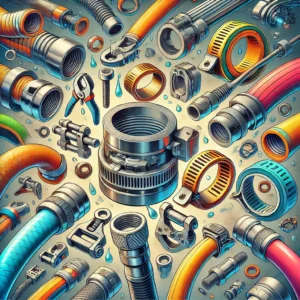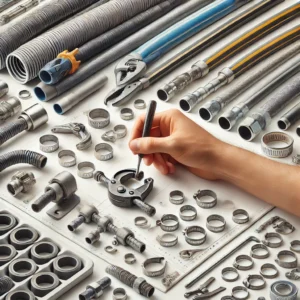The Ultimate Overview to Hoses and Clamps:
Necessary Devices for a Trustworthy Link:
When it pertains to liquid transfer systems, pipes, hoses and clamps are the vibrant duo that makes sure every little thing runs efficiently. From your automobile’s engine to your yard watering system, these little yet magnificent parts play an essential duty in producing protected, watertight links. Hoses and Clamps are the unrecognized heroes that safeguard hose pipes to installations, pipelines, or various other elements. These tools hold the hose firmly in position, avoiding leakages and keeping a safe link also under stress.
In this overview, we’ll take a deep study of hoses and clamps– what they are, the various kinds offered, their applications, and exactly how to select the best ones for your requirements. And also, we’ll conclude with a useful FAQ area to respond to typical concerns.
Allow’s begin!
What Are Hoses and Clamps?

Hoses are versatile tubes developed to move liquids, gases, or various other products. They are available in a selection of products, dimensions, and kinds to fit various applications. Whether it’s supplying gas in an automobile, sprinkling plants in your yard, or moving chemicals in a commercial setup, tubes are the foundation of liquid systems.
Kinds of Rubber Hoses:
The appropriate hose relies on the work handy. Below are several of one of the most usual kinds:
1. Rubber Hoses
- Versatile and resilient.
- Frequently utilized in auto and commercial applications.
- Immune to heat and stress.
2. Plastic Hoses
- Lightweight and flexible.
- Suitable for water transfer, horticulture, and light-duty jobs.
3. Steel Hoses
- Made from stainless steel or various other steels.
- For applications requiring high strength, including those involving extreme temperatures or stress.
4. Silicone Hoses
- Heat resistant and very adaptable.
- Popular for vehicle and medical applications.
5. Braided Hoses
- For added strength, the woven steel or textile is reinforced.
- Ideal for systems with high pressure.
6. PVC Hoses
- Budget-friendly and immune to chemicals.
- Usual in home and farming applications.
Sorts of Clamps
Similar to tubes, clamps can be found in different designs to fulfill details demands:
1. Worm Gear Clamps
- Include a screw system for tightening up.
- Ideal for use in vehicles and pipe systems.
2. Spring Clamps
- They are made from spring steel.
- They are perfect for heating and cooling systems that experience constant stress.
3. T-Bolt Clamps
- Designed for applications that require durability.
- They are perfect for systems that require high pressure.
4. Hose clamps
- With the Quick-Release mechanism, you can install and remove the product quickly.
- Use in applications that require regular maintenance.
5. Ear Clamps
- Add a device to kink the seal for long-term sealing.
- This is common in production and commercial setups.
Many different industries can use hoses and clamps.
Automotive:
- Fuel, brake, and cooling systems.
Industrial:
- Hydraulic equipment, chemical transfer systems and pneumatic-driven systems.
Agricultural:
- Water transportation and irrigation systems.
Family:
- Links to cleaning equipment, garden pipes and pipe systems.
Medical:
- Clinical gadgets for transporting liquids
Marine:
- Water and fuel supply for watercraft.
When selecting a hose to use, consider the following variables.
1. Compatible Products
- Please do not use a hose that isn’t compatible with the gas or liquid it will be transporting. Rubber tubes are ideal for gas, while PVC is best with water.
2. Size
- Choose the right inner and outer size for your system. Uneven sizes can lead to leakages and reduced efficiency.
3. Thermocouples and pressure ratings
- Choose a hose capable of managing the problems that your system may encounter. Look for optimum temperature level and stress rankings on the hose tag.
4. Versatility
- Some applications call for very versatile tubes, such as those in limited rooms or with regular motion.
5.Procedure:
- The range the hose requires to cover and purchase a somewhat longer one to enable slack.
Selecting the Right Clamp
Equally as crucial as the hose is the clamp that holds it in position.
Below’s what to take into consideration:

1. Clamp Type
Suit the clamp kind to your application. As an example, worm equipment clamps are wonderful for basic usage, while T-bolt clamps function much better for high-pressure systems.
2. size
Select a clamp that fits comfortably around your hose. A lot of clamps feature flexible varieties; however, they need to drop within the hose’s external size.
3. material
The product of the clamp must withstand rust and wear. Stainless steel clamps are long-lasting and function well in extreme atmospheres.
4. Toughness
For systems under high stress, choose clamps that offer a safe secure and solid grasp, such as T-bolt or springtime clamps.
How to Install Hoses and Clamps
Correct installment is crucial to making certain a safe, watertight link:
1. Prepare the Components
- Make sure the hose and installations are tidy and devoid of particles. Pick the best clamp dimension for the hose.
2. Affix the Hose
- Slide the hose onto the suitable pipeline. If the fit is limited, utilize a lube to assist in gliding it right into the area.
3. The Clamp Position
- Place the clamp in the correct position on the hose. Be sure not to bend or disrupt the hose.
4. Tighten the clamp.
- To tighten the clamp, use a screwdriver or wrench (depending upon which type it is). Overtightening can cause damage to the hose.
5. Check for any leaks
- Look for any leaks or loose links.
- Tighten the clamp if necessary.
How to maintain hoses and clamps
1. Watch the website
- Replace damaged elements immediately.
2. Keep Clean
- Links can be damaged by dust and other particles. Keep your clamps and pipes clean by cleaning them periodically.
3. Prevent Over-Tightening
- Overtightening the clamps can damage the hose, reducing its lifespan.
4. Change as Needed
- Also, the most effective hoses and clamps do not last permanently. Watch their problem and change them as required.
Frequently Asked Questions About Hoses and Clamps
1. What are some of the most typical products utilized for tubes?
- Rubber, PVC, silicone, and steel are some of the most usual products, selected based on the application’s demands.
2. Exactly how do I recognize what dimension clamp to make use of?
- Step the hose’s external size and select a clamp with a suitable flexible array.
3. Can I recycle clamps?
- Some clamps, like worm equipment clamps, can be recycled, while others, such as ear clamps, are made for solitary usage.
4. What triggers hose leakages?
- Leakages can arise from fractures, incorrect installment, or loosened or damaged clamps.
5. Can clamp damage tubes?
- Yes, overtightening clamps can reduce right into the hose or cause it to break gradually. Constantly tightening up is simply sufficient to avoid leakages.
Conclusion:
By comprehending the kinds readily available, choosing the appropriate ones for your demands, and keeping them appropriate, you can guarantee your systems run efficiently for many years ahead. Maintain this overview useful, and you’ll constantly be prepared to tackle your following task with self-confidence!
Hoses and clamps may feel like tiny elements. However, they are the foundation of plenty of systems. Whether you’re dealing with an auto, establishing a watering system, or working with commercial devices, picking the best hose pipes and clamps is crucial for efficiency, safety and security.
One Response